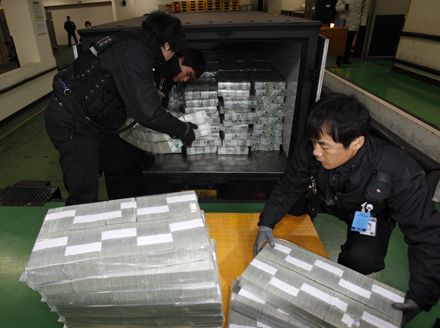While the European sovereign crisis threatens to engulf some of Europe’s biggest lenders, Asia’s financial institutions find themselves in an enviable position of strength.
Asia’s financial institutions could be forgiven for a hint of Schadenfreude over the last few years. Having been forced to accept painful restructurings of their own during the Asian financial crisis more than 10 years ago, some degree of smug satisfaction at the demise of US investment banks in 2008 – and now at the troubles facing their European peers – is inevitable.
After clamping down on reckless lending and mismatched funding models a decade earlier, Asia’s banks are riding out the ongoing western debt crises from a position of relative strength. In an industry where perception often matters more than reality, a reputation for conservative lending and no-nonsense investments is a valuable weapon.
Yet, no financial institution in today’s interconnected world can ever be entirely immune from a global financial crisis. Asia’s banks are far from perfect, but are they safe?
While not isolated from Europe’s troubles, Asian banks are in a much better structural position,
argues Ambreesh Srivastava, head of financial institutions for South and South-East Asia at Fitch Ratings.
“Asian banks do not suffer from the same structural problems of low growth and a high dependence on wholesale funding. While their performance would be impacted, under our base case, there would be minimal threat to solvency,” he said.
Most of Asia’s banks are fully funded with deposits, which continue to grow at a healthy pace across the region. Loan books only exceed deposits in Korea and Australia, but, even in those two countries, most banks are far less reliant on wholesale funding than their US or European counterparts.
That is not to say, however, that Asia can afford to ignore the rest of the world. Even with no significant direct exposure to sovereign bonds from peripheral Europe, Asian institutions remain vulnerable to global trade flows.
“Most Asian economies are dependent on trade and, as a result, counterparty obligations with European banks are substantial. A very grave situation in the West would have a bigger impact on Asian economies. So, banks still need to be vigilant,” said Srivastava.
The China factor
China, as the biggest economy by far in Asia outside of Japan, has a crucial part to play in maintaining the stability of the region’s banking system. China’s state-directed banks were instrumental in channelling billions of renminbi into the infrastructure and other stimulus projects that helped the country dodge the worst of the global recession in 2009.
Equally important will be their ability to cool the country’s runaway economic growth – and inflation – without triggering a hard landing.
It is far from clear how many of the 2009 financings will eventually become non-performing loans, but China’s regulators are certainly aware of the problem.
The required reserve ratio for China’s biggest banks stands at a punitive 21.5%, after being raised nine times since October 2010. Lending to the overheated property sector is severely restricted, with banks told to model for a correction of up to 60% in real estate prices as part of 2010’s stress tests. Efforts are under way to address the overhang of debt in the hands of local government vehicles after the first nationwide audit of public sector liabilities revealed a total debt burden of Rmb10.7trn (US$1.7trn). Regulators are extending their reach to financings outside the quota-driven lending business, clamping down on trusts and other wealth management-targeted structures.
Compared to many of the world’s biggest banks, China’s financial institutions already boast far higher capital ratios. Of the biggest five, only Agricultural Bank of China has a total capital ratio of less than 12%.
Proposed revisions to capital adequacy and risk-weighting rules will leave three Chinese banks – ABC, Bank of Communications and Bank of China – facing a Tier 1 capital shortage, according to Barclays Capital analyst May Yan. The negative impact, however, would be cushioned by the grace period, which gives the country’s biggest banks until 2013 to comply with the new regulations and other banks until 2016.
Higher quality capital
Regulators across Asia have moved to demonstrate tougher standards than those set to be introduced under Basel III.
Singapore’s banking groups barely batted an eyelid in June when the city state’s monetary authority introduced capital adequacy rules more stringent than the new Basel benchmarks.
Analysts are not expecting the arrival of the new standards to have a significant impact in Asia. Whereas European banks are under pressure to replace hybrid capital instruments that failed to absorb losses in the last financial crisis, the 7.5% core capital requirement is unlikely to be a big hurdle for Asian lenders.
“Whether by accident or by design, the negative consequences of innovation have been a lot less in Asia,” said Srivastava at Fitch. “Capital ratios are higher, and the capital itself is of better quality.”
Consolidation is also boosting confidence. Many smaller operators across South-East Asia have emerged as targets for regional and global financial institutions looking to increase their Asian footprints. Maybank’s acquisition of Singapore’s Kim Eng Holdings earlier this year highlighted the growing ambitions of Malaysia’s home-grown banking groups, while Morgan Stanley and Goldman Sachs have stepped up their efforts to expand in Indonesia, with each linked to a potential acquisition that will add to international competition in a country that is becoming an increasingly popular investment destination.
At the smaller end of the scale, three of the five Asian banks with the lowest total capital ratios are Vietnamese, according to Fitch’s data. Inflation, running at over 20%, is threatening to destabilise the economy, putting the country’s banks at obvious risk.
“There are pockets where institutions are stressed, but Asian banks are, in general, in a much better structural position – thanks to their relatively simple, deposit-funded commercial banking models,” said Srivastava.
“We expect weaker numbers, with asset quality deteriorating and credit costs rising, but Asian banks should continue to be profitable enough to absorb it through earnings.”

